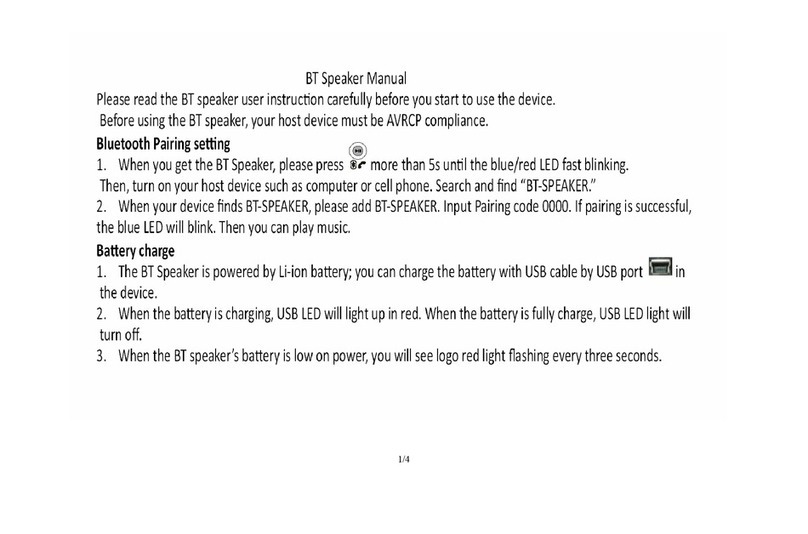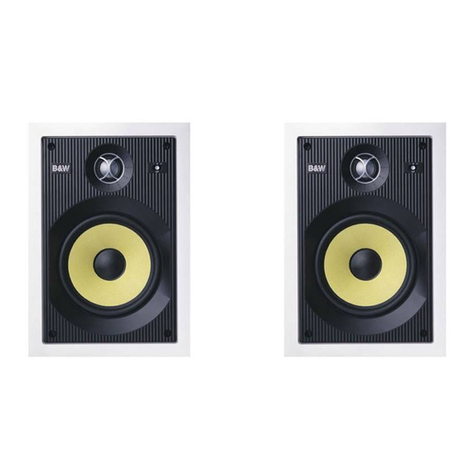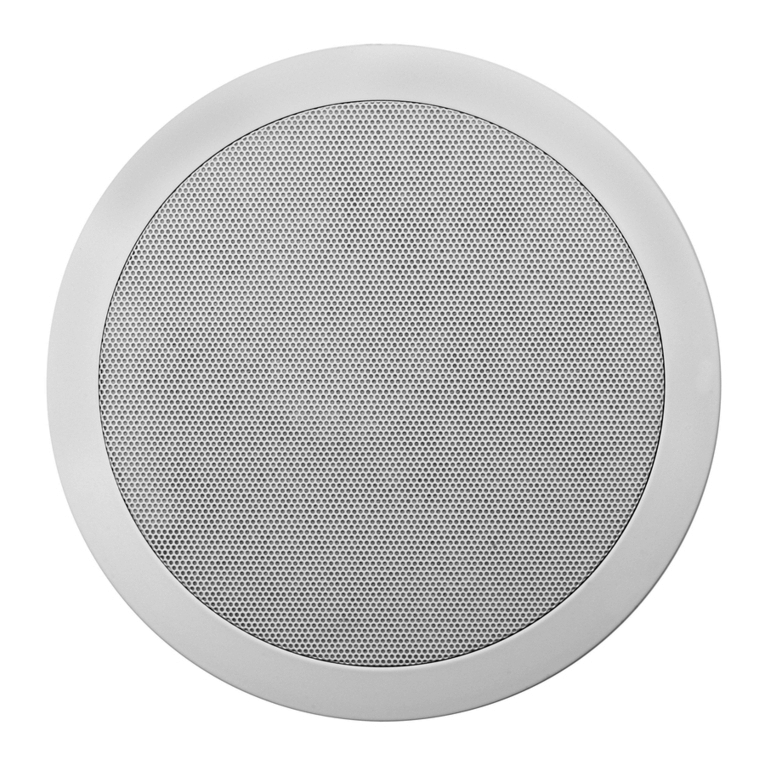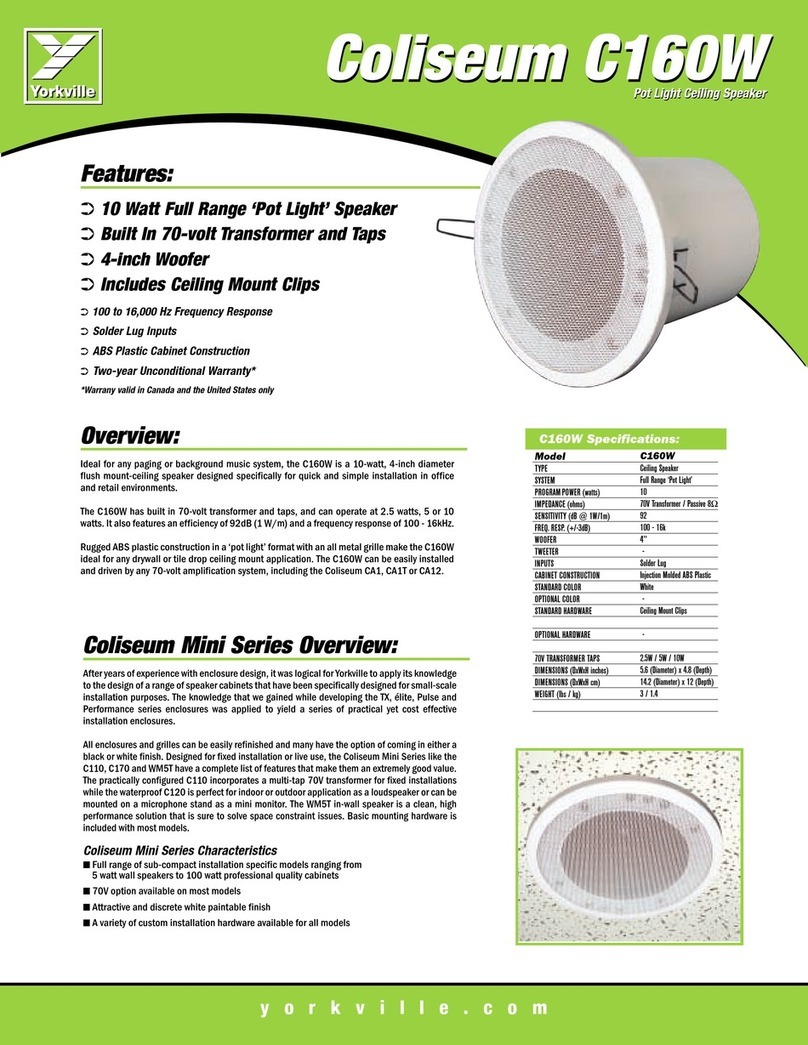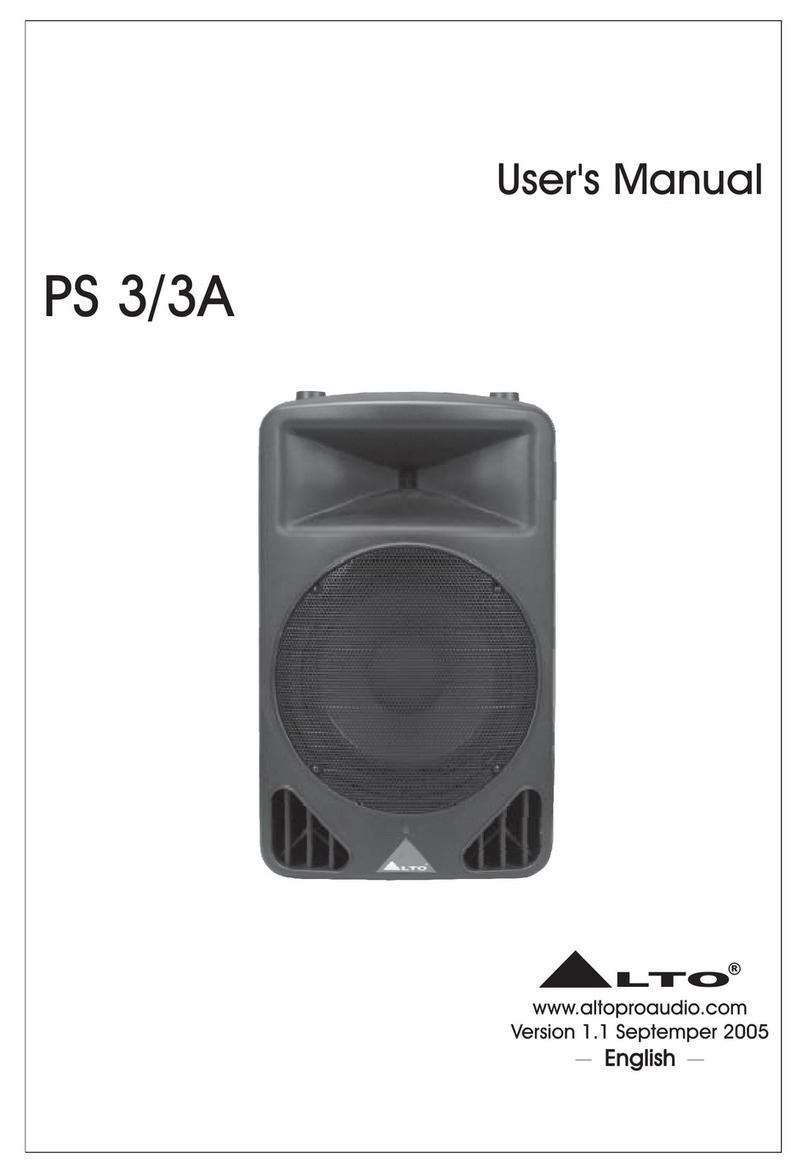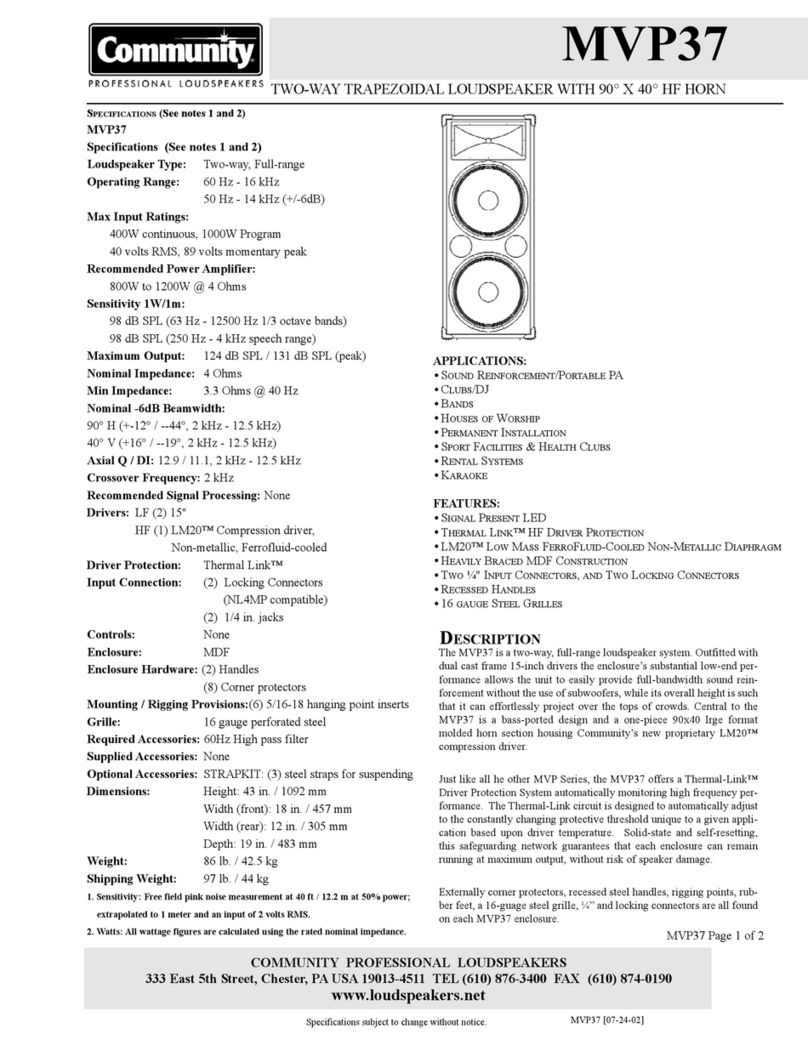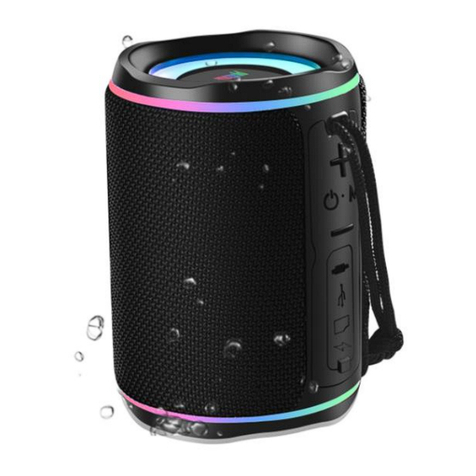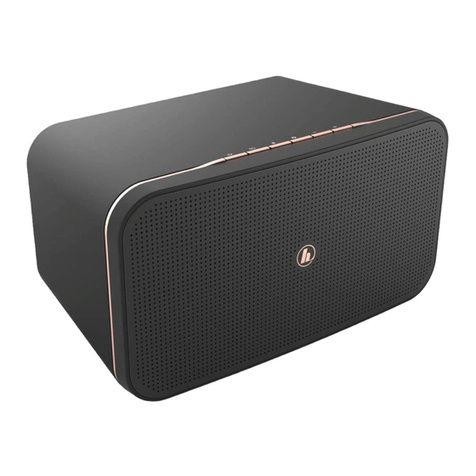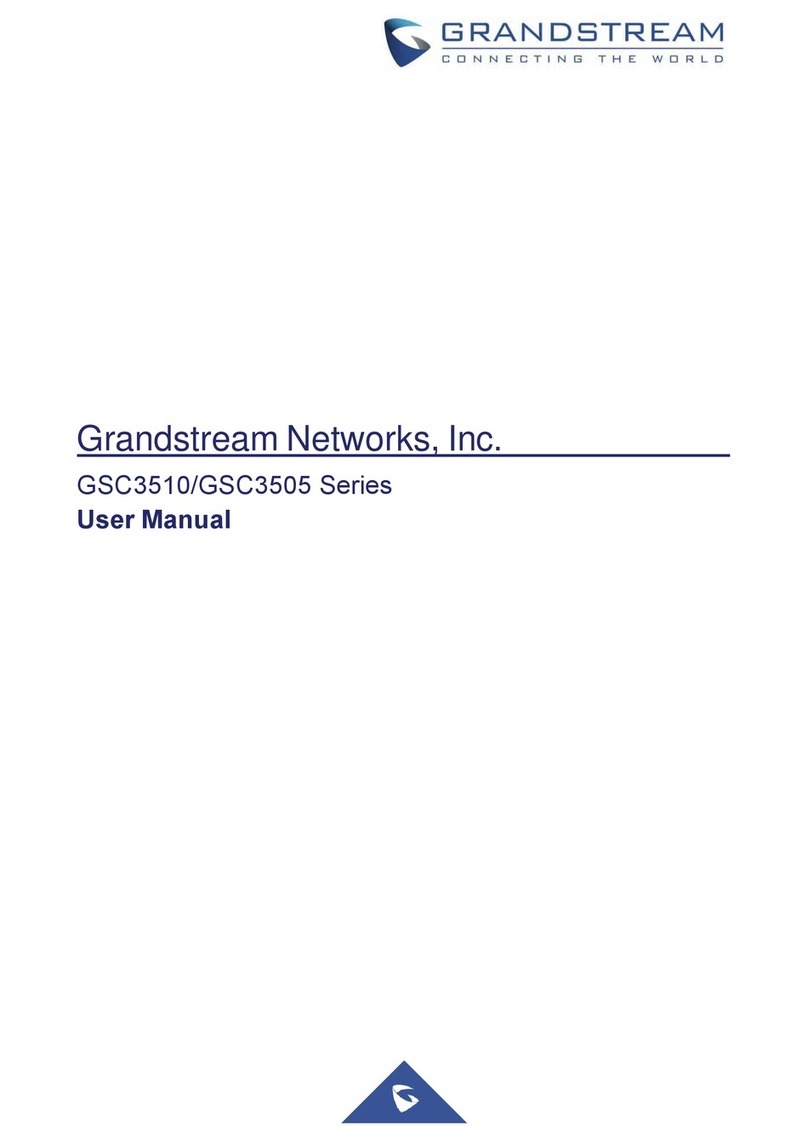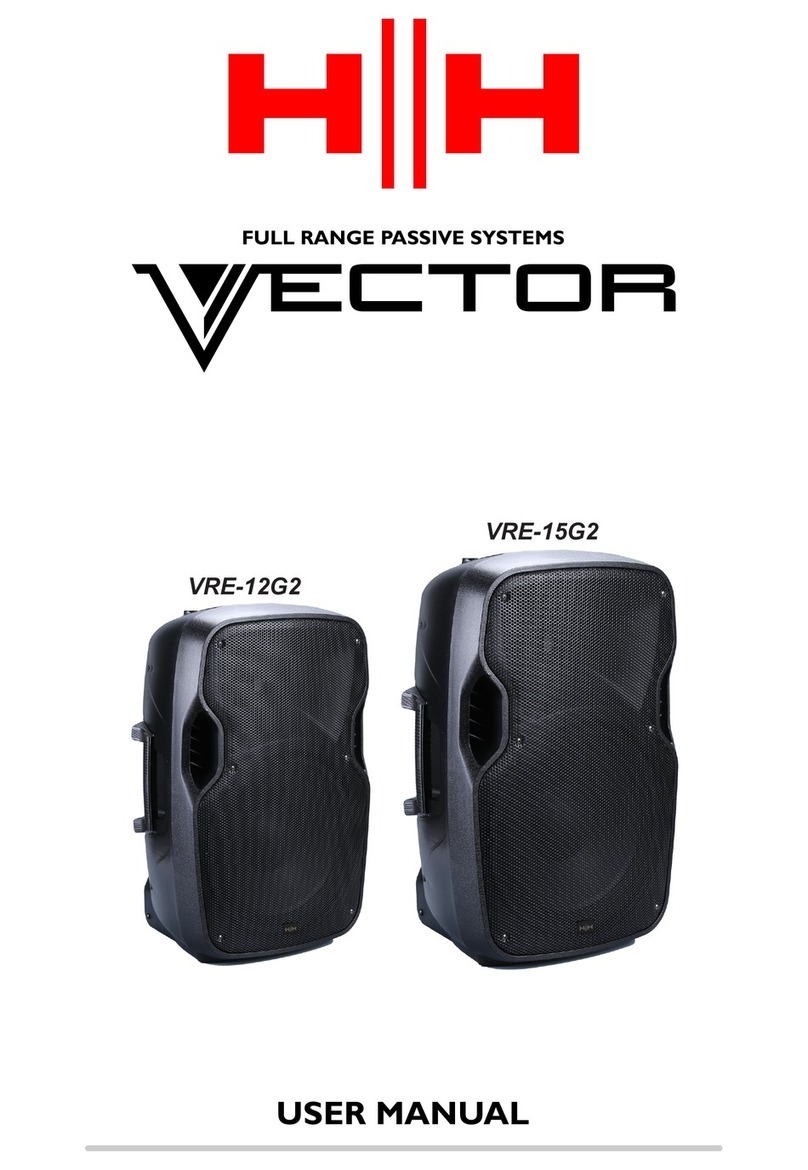Sombetzki ESL HOME User manual

Electrostatic Near-Field Loudspeaker
ESL HOME
Owner’s Manual

Electrostatic Near-Field Loudspeaker
2
www.sombetzki-elektrostaten.de
Table of Contents
1 Introduction 3
2 System description 4
3 General information 5
3.1 Policies 5
3.2 Safety instructions 5
3.3 Unpacking 6
3.4 Out of the box 6
3.5 Cleaning 6
3.6 Warranty 6
3.7 Warranty extension 6
4 Installation 7
4.1 Acoustic influences 7
5 Connecting 8
5.1 Mains connection 8
5.2 Amplifier connection 8
6 Set up 9
6.1 Orientation 9
6.2 Settings 11
6.3 Simulating headphones (stand-alone installation) 12
6.4 Adjusting bass intensity 13
7 Specifications 14

Electrostatic Near-Field Loudspeaker
3
www.sombetzki-elektrostaten.de
1Introduction
Dear Customer!
Thank you for the confidence you have shown us in acquiring this speaker. You
have chosen a quality product that meets the highest requirements both
phonetically and technically.
There is no need for the usual insertion time of this electrostatic transducer system
since this has already been done in our company.
Please read the technical description and operating instructions to fully utilize
the sound capabilities of your ESL HOME and ensure safe operation.

Electrostatic Near-Field Loudspeaker
4
www.sombetzki-elektrostaten.de
2System description
The ESL HOME has been developed for music reproduction in a quality that did not
exist previously. One single electrostatic loudspeaker chassis with a frequency
range of 37 Hz - 20 kHz is used as a sound transducer. As a result, phase shifts
between low, mid and high tweeters, such as occur with conventional multi-path
systems, are excluded from the outset. This leads to in a further advantage, the
possibility of a very close monitoring position to the listener. Known disadvantages
of loudspeaker reproduction in the room such as resonances, reverberation,
disturbing wall, ceiling and ground reflections of the sound waves, have no
influence on the listener. The use of an ultrathin (1.5 μm = 1.5 / 1000 mm), and
thus quasi massless film for the manufacture of the loudspeaker diaphragm,
makes the use of electrostatic headphones, with their known disadvantages such
as "in head location" and lacking (carrying) comfort - unnecessary in most cases.
3General Information
3.1 Policies
This product complies with the requirements of the applicable European and
national directives (Electromagnetic compatibility 89/336 / EEC).
Products made by us belong to the B2C class of the WEEE
directive and do not belong in household waste!

Electrostatic Near-Field Loudspeaker
5
www.sombetzki-elektrostaten.de
3.2 Safety instructions
As with the use of other electrical equipment, it is essential to observe the
following basic operating instructions, safety instructions and warnings in order to
ensure the optimal functioning and operational safety of the system!
Read these instructions and keep them well.
For safety reasons the unauthorized conversion and / or modification of the
loudspeaker system is not permitted.
Electrical appliances should not be operated by children
Only operate the device with the mains voltage specified on the connection
fields.
Do not install near any sources of heat.
Do not expose the device to direct sunlight.
Do not place the device in an area with high humidity.
Never insert objects into device openings.
Ensure that no fluids can penetrate the interior of the device.
Danger of electric shock if the device is open.
Always carry out repairs by qualified personnel.
Never clean the system with a wet or spray cleaner.
3.3 Unpacking
Carefully unpack the loudspeaker and check it for visible damage caused by
improper transport. If necessary, immediately report this immediately to your
supplier. Keep the package in case the speaker needs to be re-transported at a
later date.
3.4 Out of the box
Loudspeaker
Power cord
Technical description and operating instructions

Electrostatic Near-Field Loudspeaker
6
www.sombetzki-elektrostaten.de
3.5 Cleaning
The surfaces of the electronics housing can be cleaned with a clean, slightly
moistened, lint-free, soft cloth.
3.6 Warranty
Opening the device by unauthorized personnel will invalidate the warranty. No
warranty claims exist for damage caused by overload, improper handling or
external influences.
3.7 Warranty extension
As the first owner, you can extend the statutory guarantee of 2 years for a further
3 years. Please visit our homepage and complete the warranty extension form:
www.sombetzki-elektrostaten.de/garantieerweiterung.html

Electrostatic Near-Field Loudspeaker
7
www.sombetzki-elektrostaten.de
4Installation
ESL HOME is designed for ground mounting in close proximity to the listener. The
distance between the loudspeaker and the listener should not exceed 120 cm. A
distance of 60 - 100 cm (a) is optimal. The distance between the two speakers can
be between 60cm and 100cm (b). In doing so, the loudspeakers should be aligned
to the listener (see figure 1).
Figure 1: space area
4.1 Acoustic influences
The ESL HOME is a so-called dipole loudspeaker. Its sound radiation is identical
front and rear (as acoustically open), - but relative to the other side - phase-rotated
by 180°. Thus, the transducer is subject to the "acoustical short circuit". This
increases in intensity with decreasing frequency. The transmission behavior of the
ESL HOME is therefore linearized using the built-in frequency correction circuit.
The effect of this linearization is optimized to the recommended listening range.
At the same time, however, it is also influenced by the immediate spatial
Listener
Wall

Electrostatic Near-Field Loudspeaker
8
www.sombetzki-elektrostaten.de
environment (walls, furniture, etc.). On these objects, the sound waves, in
particular those of the low frequencies, are reflected (mirrored) and thus perceived
by the listener as a powerful reproduction. A monitoring position without reflectors
(for example in the center of the room) is therefore not recommended.
5. Connecting the speakers
In this chapter, you will learn how to connect your speakers to the power supply
and to the signal source.
5.1 Mains connection
The ESL HOME is an electrostatic transducer and operates with a diaphragm
charged at a high voltage of approximately 6 kV. The required voltage supply is
taken from the power supply network and brought to the required value by means
of a voltage multiplier. The power consumption is thereby small (under 0.3 watts),
so that a power switch was omitted deliberately. On the other hand, an
electrostatic sound transducer needs a certain charging time (several hours) after
the commissioning in order to provide the maximum sound quality. It is therefore
advisable to keep the ESL HOME permanently to the mains.
5.2 Amplifier connection
The ESL HOME has two pairs of isolated pole terminals (4mm), which can be
connected to your amplifier (see figure 2). In order to meet the respective living
and installation situations (e.g. sofa or armchair), connections for amplifiers and
power supply are available on both narrow sides of the electronic housing. One
side is always kept closed by a screwed cover (logo plate). This is necessary for
safety reasons. The trained dealer will set up the required connection area for
your needs. Please do not try to do the conversion yourself if you are not an
expert. Never operate your ESL HOME without the cover.

Electrostatic Near-Field Loudspeaker
9
www.sombetzki-elektrostaten.de
Figure 2: One of two connection panels
Please note the maximum power rating of the ESL HOME when connecting your
amplifier (see technical specifications). To achieve the highest sound quality, high
quality amplifiers should be selected. The ESL HOME is not "impedance critical".
Both tube and transistor amplifiers are suitable. "Single Ended" amplifiers have
been successfully tested.
6 Set up
6.1 Orientation
As mentioned in point 4 (Installation), your ESL HOME will be placed close to the
listening position. For this purpose, two example of placement option are given:
Single place (armchair, chair, etc.)
Multi-seat arrangement (sofa, seating groups, etc.)
Single place
Before you begin setting up your ESL Home, you need to locate the left and right
speakers. You will find the serial number on the LOGO shield. It ends with a letter
("L" or "R"), which means left or right. Your ESL HOME will set up with the longer
side of the electronic housing parallel to your left and right side. In this way, little
living space is "lost" (see graph 3). The connection panel is now located on the
narrow side facing the wall (factory version). Now move your ESL HOME so far
forward and to the side that you can perform the settings and angle settings
described in point 4.

Electrostatic Near-Field Loudspeaker
10
www.sombetzki-elektrostaten.de
Figure 3: Installation at the listening position (single user)
Multi-seat arrangement
Your ESL HOME is placed parallel to the seat with the narrow side of the electronic
housing. The places next to you are "blocked". Position your ESL HOME in away
that the height-adjustable pipe is facing the inside (facing the seat). Under this
prerequisite, you can adjust the optimum listening position by turning the speaker
heads. To ensure that the connection cables do not run in the "wrong" direction
during this installation, the opposing connection panel can be released in order to
carry out the cabling (see section 5.2).
Please do not forget to screw on the cover (LOGO) of the unused panel before
restoring the power supply. Never operate your ESL HOME without this cover.
Logo Cover: second connection panel

Electrostatic Near-Field Loudspeaker
11
www.sombetzki-elektrostaten.de
6.2 Settings
Height adjustment
The optimum listening position relative to the height is located in the middle of the
transducer. The loudspeaker head is height-adjustable so that you can adjust your
center position on different seating areas. You will find a hand wheel on the pipe
side of the head. Rotate to the left to loosen it. Now you can touch the head with
both hands and move up or down and then tighten it by turning the wheel to the
right. The displacement range is approx. 20 cm. (See figure 5).
Figure 5: Hand wheel on head
Horizontal angle
An additional handwheel is located on the electronic housing (see figure 6). After
you have loosened it (turn to the left), the loudspeaker head can be rotated about
90° around the tube axis. This allows the transducer to be angled to your ears
(mentioned in point 4). Try different angles. The benchmark is your personal
"taste". However, it should be noted that both "heads" should be at approximately
the same angle to you. For this purpose, read off the angle at the lower end of the
pipe and set the same value on the second ESL Home (see figure 7).

Electrostatic Near-Field Loudspeaker
12
www.sombetzki-elektrostaten.de
Figure 6: Handwheel on electronic housing Figure 7: Setting aid angle scale
6.3 Simulating headphones (stand-alone mode)
Place the loudspeakers parallel to each other: The transducers are exactly at ear
level. Then the angle to your face is 90°. The difference to an attached headphone
is now (acoustically) only at the distance of the sound transducer to your ears. In
this position, so-called dummy head recordings that were originally produced for
headphone playback can be listened to in adequate quality. Recent binaural+
recordings also benefit from this lineup.

Electrostatic Near-Field Loudspeaker
13
www.sombetzki-elektrostaten.de
6.4 Adjusting bass intensity
The reproduction intensity of the low frequencies depends on the set-up (see
Section 4 ff) and the amplifier used (such as a tube or transistor amplifier).
With the switch mounted on one connection panel, the bass can be raised by 3 dB
(B + position) in the range of 40 to about 70 hertz.
Figure 8: Bass boost

Electrostatic Near-Field Loudspeaker
14
www.sombetzki-elektrostaten.de
7 Specifications
Field of application:
Maximum SPL of 100 Hz…8 kHz:
Frequency response:
Impedance:
Diaphragm stroke:
Maximum amplifier power:
Operating voltage:
Power consumption:
Mains connection:
Loudspeaker systems:
Dimensions (h * w * d cm):
Weight:
Climatic conditions
Working temperature range:
Storage temperature range:
Relative humidity:
Housing design (Electronics):
Grille cloth:
home speaker for listening distances 60 cm
... 120 cm
102 dB / 1m
37 … 21 kHz ± 3 dB / 60 cm
4 –8 Ω
± 4 mm
75 - 80 W (25Veff max.)
230VAC 50/60 Hz
< 0.5 W
IEC appliance inlet C8
One electrostatic broadband transducer
(50 * 30 * 3.6 cm)
115 * 44 * 14.5
(without stainless steel stabilizer)
approx. 21 kg
0 … + 40°C
-25 … + 40°C
5 % ... 90 %
MDF basalt gray lacquered with side decors
in various wood types or RAL-colors
available in different colors
standard: silver-gray

Electrostatic Near-Field Loudspeaker
15
www.sombetzki-elektrostaten.de
For more information and updates: www.Sombetzki-Elektrostaten.de
Sombetzki-Elektrostaten
Lautsprecherentwicklung für Studio- und Heimanwendungen
Am Plättchen 29
D-35418 Buseck / Hessen
Tel. +49(0) 549 0 240
E-Mail: info@sombetzki-elektrostaten.de
WEEE-Reg.-Nr. DE 93743649
Table of contents
